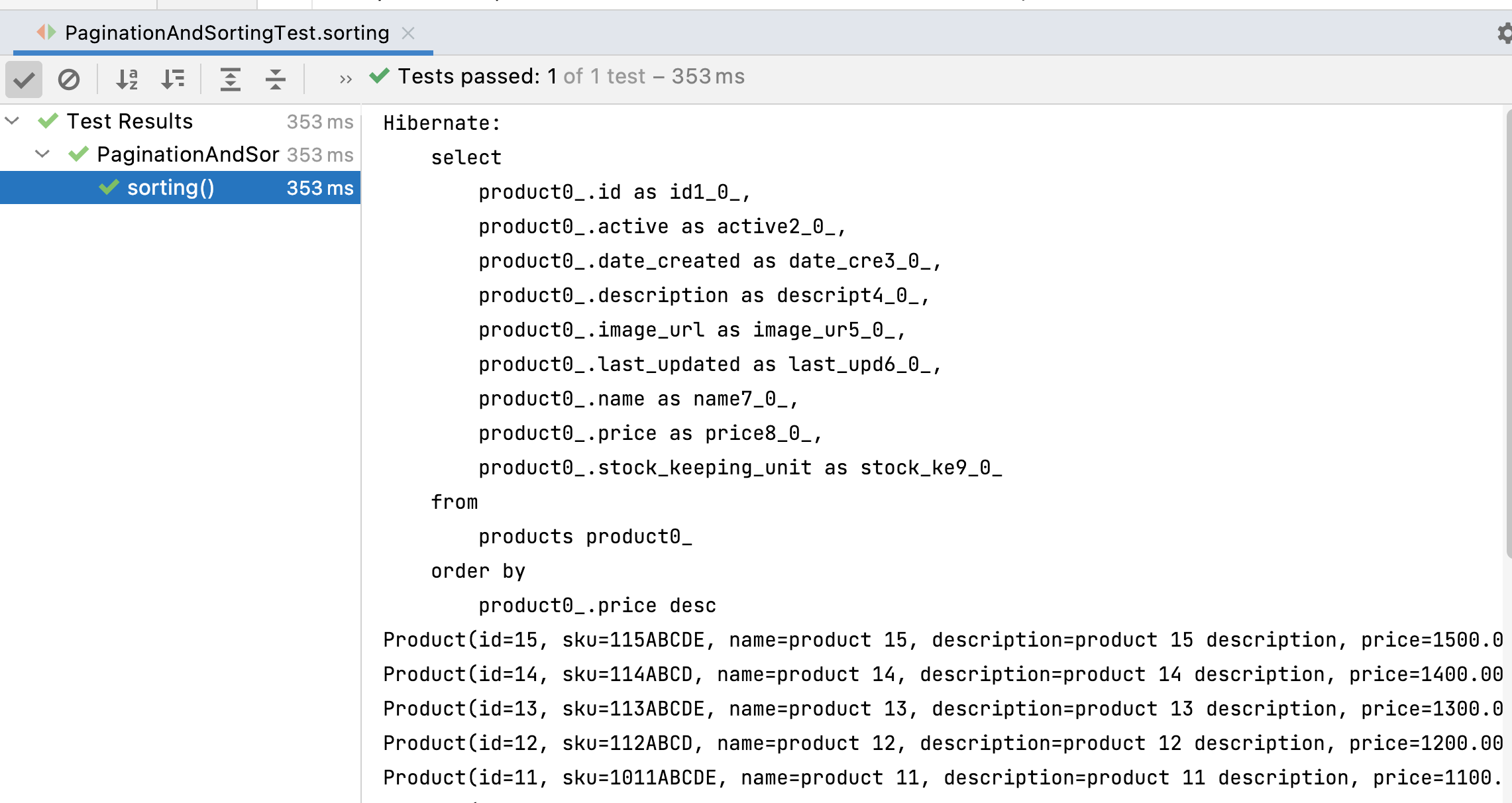Spring Data JPA Sorting Overview
- Page findAll(Pageable pageable) – returns a Page of entities meeting the paging restriction provided in the Pageable object.
- Iterable findAll(Sort sort) – returns all entities sorted by the given options. No paging is applied here.
@NoRepositoryBean
public interface PagingAndSortingRepository < T, ID > extends CrudRepository < T, ID > {
/**
* Returns all entities sorted by the given options.
*
* @param sort
* @return all entities sorted by the given options
*/
Iterable < T > findAll(Sort sort);
/**
* Returns a {@link Page} of entities meeting the paging restriction provided in the {@code Pageable} object.
*
* @param pageable
* @return a page of entities
*/
Page < T > findAll(Pageable pageable);
}Iterable < T > findAll(Sort sort);Note: Spring Data JPA has SimpleJPARepository class which implements PagingAndSortingRepository interface methods so we don't have to write a code to implement PagingAndSortingRepository interface methods.
1. Creating Spring Boot Project
Spring Boot provides a web tool called https://start.spring.io to bootstrap an application quickly. Just go to https://start.spring.io and generate a new spring boot project.Use the below details in the Spring boot creation:
Project Name: spring-data-jpa-course
Project Type: Maven
Choose dependencies: Spring Data JPA, MySQL Driver, Lombok
Package name: net.javaguides.springboot
Use the below details in the Spring boot creation:
Project Name: spring-data-jpa-course
Project Type: Maven
Choose dependencies: Spring Data JPA, MySQL Driver, Lombok
Package name: net.javaguides.springboot
2. Maven Dependencies
Here is the complete pom.xml for your reference:
<?xml version="1.0" encoding="UTF-8"?>
<project xmlns="http://maven.apache.org/POM/4.0.0" xmlns:xsi="http://www.w3.org/2001/XMLSchema-instance"
xsi:schemaLocation="http://maven.apache.org/POM/4.0.0 https://maven.apache.org/xsd/maven-4.0.0.xsd">
<modelVersion>4.0.0</modelVersion>
<parent>
<groupId>org.springframework.boot</groupId>
<artifactId>spring-boot-starter-parent</artifactId>
<version>3.0.4</version>
<relativePath/> <!-- lookup parent from repository -->
</parent>
<groupId>net.javaguides</groupId>
<artifactId>spring-data-jpa-course</artifactId>
<version>0.0.1-SNAPSHOT</version>
<name>spring-data-jpa-course</name>
<description>Demo project for Spring Boot</description>
<properties>
<java.version>17</java.version>
</properties>
<dependencies>
<dependency>
<groupId>org.springframework.boot</groupId>
<artifactId>spring-boot-starter-data-jpa</artifactId>
</dependency>
<dependency>
<groupId>com.mysql</groupId>
<artifactId>mysql-connector-j</artifactId>
<scope>runtime</scope>
</dependency>
<dependency>
<groupId>org.springframework.boot</groupId>
<artifactId>spring-boot-starter-test</artifactId>
<scope>test</scope>
</dependency>
</dependencies>
<build>
<plugins>
<plugin>
<groupId>org.springframework.boot</groupId>
<artifactId>spring-boot-maven-plugin</artifactId>
</plugin>
</plugins>
</build>
</project>3. Configure MySQL database
Let's use the MySQL database to store and retrieve the data in this example and we gonna use Hibernate properties to create and drop tables.
Open the application.properties file and add the following configuration to it:spring.datasource.url=jdbc:mysql://localhost:3306/demo?useSSL=false
spring.datasource.username=root
spring.datasource.password=Mysql@123
spring.jpa.properties.hibernate.dialect = org.hibernate.dialect.MySQLDialect
spring.jpa.hibernate.ddl-auto = create-drop
spring.datasource.url=jdbc:mysql://localhost:3306/demo?useSSL=false
spring.datasource.username=root
spring.datasource.password=Mysql@123
spring.jpa.properties.hibernate.dialect = org.hibernate.dialect.MySQLDialect
spring.jpa.hibernate.ddl-auto = create-drop
4. Create JPA Entity - Product.java
Let's create an entity package inside a base package "net.javaguides.springboot".
Within the entity package, create a Product class with the following content:import lombok.*;
import org.hibernate.annotations.CreationTimestamp;
import org.hibernate.annotations.UpdateTimestamp;
import jakarta.persistence.*;
import java.math.BigDecimal;
import java.time.LocalDateTime;
@Entity
@Getter
@Setter
@NoArgsConstructor
@AllArgsConstructor
@ToString
@Table(
name = "products",
schema = "ecommerce",
uniqueConstraints = {
@UniqueConstraint(
name = "sku_unique",
columnNames = "stock_keeping_unit"
)
}
)
public class Product {
@Id
@GeneratedValue(
strategy = GenerationType.SEQUENCE,
generator = "product_generator"
)
@SequenceGenerator(
name = "product_generator",
sequenceName = "product_sequence_name",
allocationSize = 1
)
private Long id;
@Column(name = "stock_keeping_unit", nullable = false)
private String sku;
@Column(nullable = false)
private String name;
private String description;
private BigDecimal price;
private boolean active;
private String imageUrl;
@CreationTimestamp
private LocalDateTime dateCreated;
@UpdateTimestamp
private LocalDateTime lastUpdated;
}
import lombok.*;
import org.hibernate.annotations.CreationTimestamp;
import org.hibernate.annotations.UpdateTimestamp;
import jakarta.persistence.*;
import java.math.BigDecimal;
import java.time.LocalDateTime;
@Entity
@Getter
@Setter
@NoArgsConstructor
@AllArgsConstructor
@ToString
@Table(
name = "products",
schema = "ecommerce",
uniqueConstraints = {
@UniqueConstraint(
name = "sku_unique",
columnNames = "stock_keeping_unit"
)
}
)
public class Product {
@Id
@GeneratedValue(
strategy = GenerationType.SEQUENCE,
generator = "product_generator"
)
@SequenceGenerator(
name = "product_generator",
sequenceName = "product_sequence_name",
allocationSize = 1
)
private Long id;
@Column(name = "stock_keeping_unit", nullable = false)
private String sku;
@Column(nullable = false)
private String name;
private String description;
private BigDecimal price;
private boolean active;
private String imageUrl;
@CreationTimestamp
private LocalDateTime dateCreated;
@UpdateTimestamp
private LocalDateTime lastUpdated;
}Note that we are using Lombok annotations to reduce the boilerplate code.
5. Create Spring Data JPA Repository
The next thing we’re gonna do is to create a repository to access Product entity data from the database.
The JpaRepository interface defines methods for all the CRUD operations on the entity, and a default implementation of the JpaRepository called SimpleJpaRepository.
Let's create a repository package inside a base package "net.javaguides.springdatarest".
Within the repository package, create a ProductRepository interface with the following content:import com.springdatajpa.springboot.entity.Product;
import org.springframework.data.jpa.repository.JpaRepository;
import org.springframework.data.repository.query.Param;
import java.math.BigDecimal;
public interface ProductRepository extends JpaRepository<Product, Long>
{
}
The next thing we’re gonna do is to create a repository to access Product entity data from the database.
The JpaRepository interface defines methods for all the CRUD operations on the entity, and a default implementation of the JpaRepository called SimpleJpaRepository.
import com.springdatajpa.springboot.entity.Product;
import org.springframework.data.jpa.repository.JpaRepository;
import org.springframework.data.repository.query.Param;
import java.math.BigDecimal;
public interface ProductRepository extends JpaRepository<Product, Long>
{
}6. Spring Data JPA Sorting Implementation
import com.springdatajpa.springboot.entity.Product;
import org.junit.jupiter.api.Test;
import org.springframework.beans.factory.annotation.Autowired;
import org.springframework.boot.test.context.SpringBootTest;
import org.springframework.data.domain.Sort;
import java.util.List;
@SpringBootTest
public class PaginationAndSortingTest {
@Autowired
private ProductRepository productRepository;
@Test
void sorting(){
String sortBy = "price";
String sortDir = "desc";
Sort sort = sortDir.equalsIgnoreCase(Sort.Direction.ASC.name())?
Sort.by(sortBy).ascending(): Sort.by(sortBy).descending();
List<Product> products = productRepository.findAll(sort);
products.forEach((p) ->{
System.out.println(p);
});
}
}
Sort sort = sortDir.equalsIgnoreCase(Sort.Direction.ASC.name())?
Sort.by(sortBy).ascending(): Sort.by(sortBy).descending();
List<Product> products = productRepository.findAll(sort);Output:
select
product0_.id as id1_0_,
product0_.active as active2_0_,
product0_.date_created as date_cre3_0_,
product0_.description as descript4_0_,
product0_.image_url as image_ur5_0_,
product0_.last_updated as last_upd6_0_,
product0_.name as name7_0_,
product0_.price as price8_0_,
product0_.stock_keeping_unit as stock_ke9_0_
from
products product0_
order by
product0_.price descRelated Spring Data JPA Examples
- Spring Data JPA - Pagination Example
- Spring Data JPA - Sorting Example
- Spring Data JPA - Sorting with Multiple Fields or Columns
Learn and master Spring Data JPA at Spring Data JPA Tutorial. // 50+ Spring Data JPA examples




Comments
Post a Comment
Leave Comment